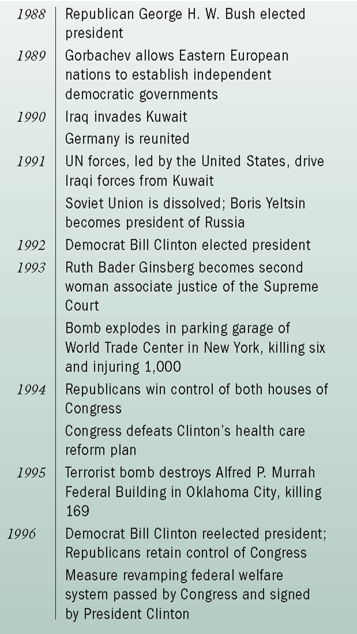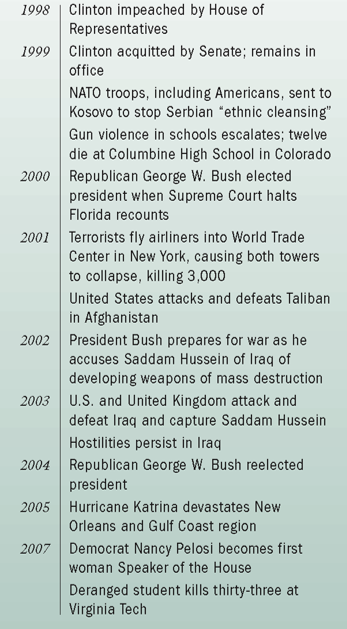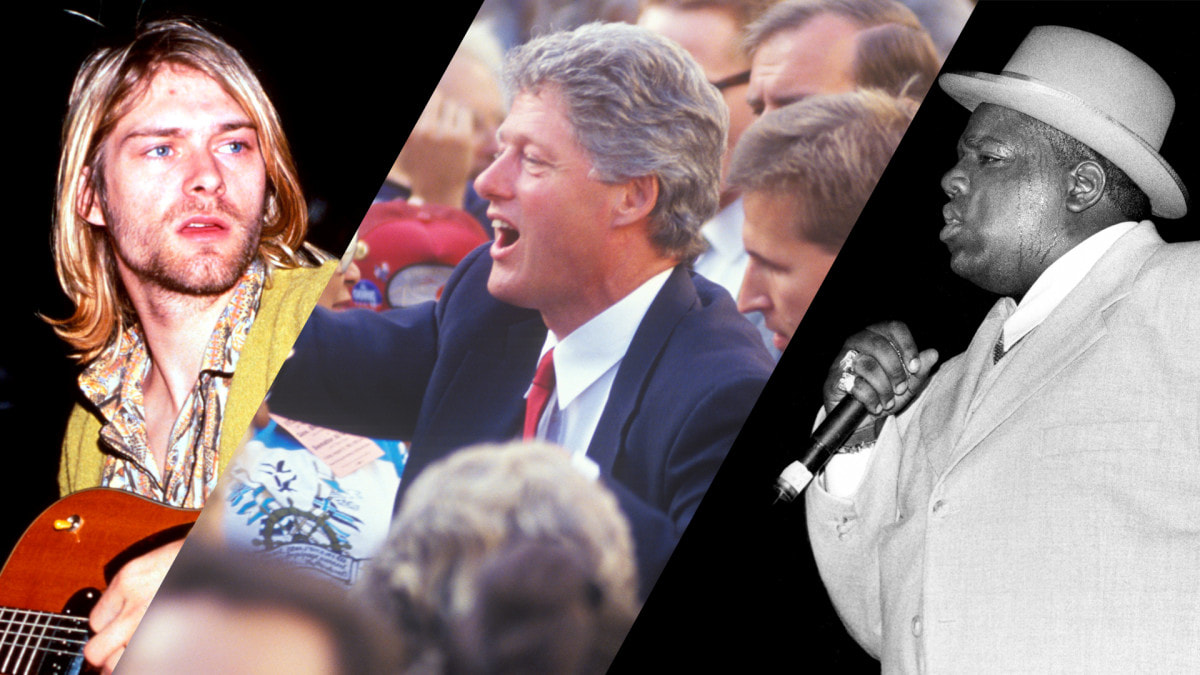|
Week 13: Close of the 20th Century
Welcome to HST 202 Week Thirteen! This is the thirteenth learning module looking at the waning years of the 20th century in the United States.
HIGHLIGHTS
READING
Carnes, Chapter 32: Shocks and Responses: 1992-Present My classes utilize both Howard Zinn's Patriot's History of the United States and Larry Schweikart's Patriot's History of the United States, mostly in excerpts posted to the modules. You can access the full text of People's History or Patriot's History by clicking on the links. 
Zinn, Chapter 23 “The Clinton Presidency and the Crisis of Democracy”
President Bill Clinton was reelected in 1996 with a distinct lack of voter enthusiasm. As was true in 1992 (when 19 percent of the voters showed their distaste for both parties by voting for a third-party candidate, Ross Perot), the electorate was clearly not happy about its choices. Half of the eligible voters stayed away from the polls, and of those who did vote, only 49 percent chose Clinton over his lackluster opponent, Robert Dole. One bumper sticker read: "If God had intended us to vote, he would have given us candidates…" …"The era of big government is over," Clinton proclaimed as he ran for president, seeking votes on the supposition that Americans supported the Republican position that government was spending too much for social programs. But both parties were misreading public opinion. The press was often complicit in this. When, in the midyear election of 1994, only 37 percent of the electorate went to the polls, and slightly more than half voted Republican, the media reported this as a "revolution." A headline in the New York Times read "Public Shows Trust in GOP Congress," suggesting that the American people were supporting the Republican agenda of less government. But in the story below that headline, a New York Times/CBS News public opinion survey found that 65 percent of those polled said that "it is the responsibility of government to take care of people who can't take care of themselves." Clinton and the Republicans, in joining against "big government," were aiming only at social services. The other manifestations of big government-huge contracts to military contractors and generous subsidies to corporations-continued at exorbitant levels. "Big government" had, in fact, begun with the Founding Fathers, who deliberately set up a strong central government to protect the interests of the bondholders, the slave owners, the land speculators, the manufacturers. For the next two hundred years, the American government continued to serve the interests of the wealthy and powerful, offering millions of acres of free land to the railroads, setting high tariffs to protect manufacturers, giving tax breaks to oil corporations, and using its armed forces to suppress strikes and rebellions. It was only in the twentieth century, especially in the thirties and sixties, when the government, besieged by protests and fearful of the stability of the system, passed social legislation for the poor that political leaders and business executives complained about "big government…" …The United States, with 5 percent of the earth's population, consumed 30 percent of what was produced worldwide. But only a tiny portion of the American population benefited; this richest 1 percent of the population saw its wealth increase enormously starting in the late 1970s. As a result of changes in the tax structure, by 1995 that richest 1 percent had gained over a trillion dollars and now owned over 40 percent of the nation's wealth. According to the business magazine Forbes, the 400 richest families owned $92 billion in 1982. Thirteen years later, this had jumped to $480 billion. The Dow Jones average of stock prices had gone up 400 percent between 1980 and 1995, while the average wage of workers had declined in purchasing power by 15 percent. It was therefore possible to say that the U.S. economy was "healthy"-but only if you considered the richest part of the population. Meanwhile, 40 million people were without health insurance, and infants died of sickness and malnutrition at a rate higher than that of any other industrialized country. For people of color, the statistics were worse: Infants died at twice the rate of white children, and the life expectancy of a black man in Harlem, according to a United Nations report, was 46 years, less than that in Cambodia or the Sudan. The United States (forgetting, or choosing to forget, the disastrous consequence of such a policy in the twenties) was consigning its people to the mercy of the "free market." The "market" did not care about the environment or the arts. And it left many Americans without jobs, or health care, without a decent education for their children, or adequate housing. Under Reagan, the government had reduced the number of housing units getting subsidies from 400,000 to 40,000; in the Clinton administration the program ended altogether. Despite Clinton's 1997 Inaugural Day promise of a "new government," there was no bold program to take care of these needs. Such a program would require huge expenditures of money. There were two ways of raising this money, but the Clinton administration (like its predecessors) was not inclined to turn to them, given the powerful influence of corporate wealth…
ASSIGNMENTS
Forum Discussion #14
Joseph Saddler, better known by his stage name Grandmaster Flash, is an American hip-hop recording artist and DJ. He is considered one of the pioneers of hip-hop DJing, cutting, scratching and mixing. His song, “The Message” is considering by Rolling Stone to be the greatest hip-hop track of all time. Listen to this toe-tappin’ tune and answer the following:
How has African American culture at large influenced mainstream pop culture since the advent of hip-hop music? How is "The Message" an indictment of being a person of color OR person of lower economic status in America? Please cite examples. Need help? Remember the Discussion Board Rubric.
0 Comments
Leave a Reply. |
AuthorRyan Lancaster wears many hats. Dive into his website to learn about history, sports, and more! Archives
April 2024
Categories |







 RSS Feed
RSS Feed